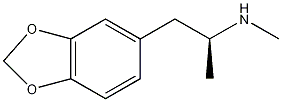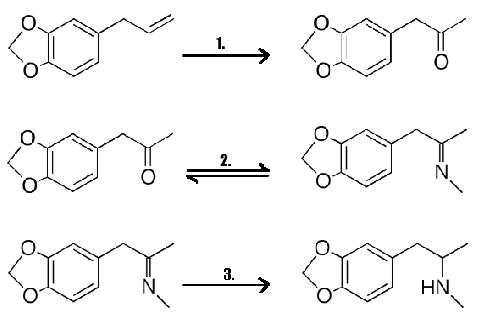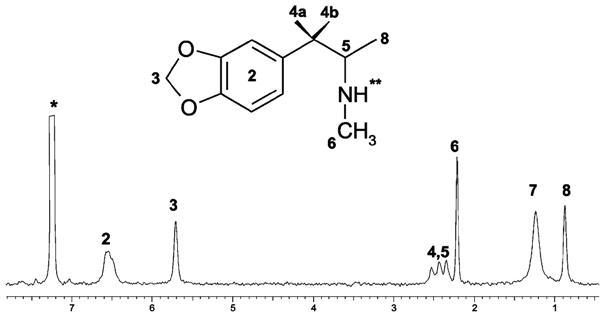It07:Methylenedioxymethamphetamine
Methylenedioxymethamphetamine
Often known as MDMA or Ecstacy, 3,4-methylenedioxy-N-methylamphetamine is a semisynthetic empathogen-entactogen, an illegal drug that acts as a stimulant producing an psychedelic energizing effect, as well as distortions in time, perception and enhanced enjoyment of tactile experiences. MDMA exerts its primary effects on neurons in the brain that use the chemical serotonin to communicate with other neurons. Aside from recreational purposes, it is used as a tool to supplement various practices including meditation, psychonautics, and illicit psychedelic psychotherapy. Research in animals indicates that MDMA is neurotoxic; whether or not this is also true in humans is currently an area of intense investigation. MDMA can also be dangerous to health and, on rare occasions, lethal.
| Methylenedioxymethamphetamine | |||
|---|---|---|---|

| |||
| General | |||
| Systematic name | 3,4-methylenedioxy-N-methylamphetamine | ||
| Other names | N-methyl 1-1-(3,4-methylenedioxyphenyl)-2-propanamine, MDMA, Ecstacy | ||
| Molecular formula | C11H15NO2 | ||
| SMILES | CN[C@@H](C)CC1=CC(OCO2)=C2C=C1 | ||
| Molar mass | 193.24g/mol | ||
| Appearance | White crystalline solid | ||
| CAS number | 69610-10-2 | ||
| Properties | |||
| Melting point | -144.4F | ||
| Boiling point | 148 F | ||
| Hazards | |||
| MSDS | External MSDS | ||
| Main hazards | Neurotoxic | ||
| Supplementary data page | |||
| Structure and properties |
n, εr, etc. | ||
| Thermodynamic data |
Phase behaviour Solid, liquid, gas | ||
| Spectral data | UV, IR, NMR, MS | ||
| Related compounds | |||
| Related compounds | Amphetamine, MDEA, Methylenedioxymethcathinone, Paramethoxyamphetamine. | ||
| Except where noted otherwise, data are given for materials in their standard state (at 25 °C, 100 kPa) Infobox disclaimer and references | |||
HistoryMDMA was first synthesized in 1912, soon after it was patented in Germany by the Merck Company. At that time it was not the subject of human research, but Merck stumbled across MDMA when they tried to synthesize Hydrastinin, a vasoconstrictive and styptic medicine. MDMA was an unplanned by-product of this synthesis. In the 1950s it was briefly researched by the U.S. Government as part of the CIA's and the Army's chemical warfare investigations into MDMA as a truth serum, which proved to be unsuitable. The first reported recreational use was in the 1960s, where it became known as the love drug. In the mid-70s, the psychedelic therapy community rediscovered it and psychiatrists and therapists began to use it to supplement psychotherapy. In the early 1980s, the drug began to be used recreationally, most notably in Dallas, under the name the street name 'Ecstasy'. The non-medical and therapeutic use of MDMA was made illegal in the USA in 1985. Soon afterwards its use rapidly spread outside the United States, where it was widely used in the UK and other parts of Europe, becoming an integral part of the rave subculture and other psychedelic and dancefloor influenced music scenes.[2] SynthesisReaction Overview: The 'ketone' approach is one of many synthesis schemes for the production of MDMA. This basic scheme is the oxidation of the plant oil 'safrole' (1-allyl-3,4-methylenedioxybenzene) into a ketone (3,4-methylenedioxyphenyl-2-propanone), which is then condensed with methylamine and reduced to the final MDMA product. Step 1: Peroxyacid oxidation (requires isomerization of safrole). Step 2: Reversible imine formation, which reacts spontaneously when the ketone is added to a solution of methylamine. Step 3: Reduction, permanently converts the imine to MDMA. [3] Effects on the Human BodyThe most common use of MDMA is for recreational purposes. Classed as a stimulant, the effects produced on the human body include euphoria, increased awareness of the senses, feelings of openness, empathy, heightened self-awareness and feeling of mental clarity. Tactile sensations are enhanced for some users resulting in physical contact with others more intense. ‘Alexander Shulgin stated that the single best use of MDMA was to facilitate more direct communication between people involved in significant emotional relationships.’ Physical effects on the body include sweaty palms, heavy sweating, increased heart rate, increased body temperature, and heightened touch sensations. Naturally there are many health risks involved in taking a stimulant such as MDMA. Physically these risks include hypertension, dehydration and hyperthermia. This is mostly due to the drug's stimulatory effects masking the body's normal sense of exhaustion and thirst. MDMA is also neurotoxic which means it interferes with brain chemistry, sometimes permanently. The metabolism of MDMA leads to the lipid peroxidation of serotonergic neurons, thus interfering with the brain's ability to effectively use serotonin. Psychologically, MDMA use often results in a rebound period of poor mood, often known as a ‘comedown’. Obviously this varies in length between different users but can often lead to lasting depression and anxiety in vulnerable users. The longer the time MDMA is active in the brain, the greater the neurotoxic damage to the brain and the greater the risk of short-term emotional problems. The more times MDMA is taken, the greater the risk of any long-term problems. Short Term EffectsIn significantly high doses, MDMA can interfere with the body’s ability to regulate temperature, thus effecting homeostasis. On the very rare, but unpredictable occasions, this can possibly lead to a quick sharp increase in body's core temperature (leads to hyperthermia), resulting in failure in the following major organs; liver, kidney, and in cardiovascular system and the worst case scenario is death. MDMA is a drug that can unfortunately interfere with the body's metabolism of the drug and this can lead to potentially harmful levels, especially if the drug is repeatedly used in a short space of time. Users of MDMA can face many of the same risks/side effects as casual and frequent users of other stimulants; like cocaine and amphetamines. These typically include increases in heart rate and blood pressure, which is has significantly higher risk for people with either circulatory problems or heart disease, and other symptoms include muscle tension, involuntary teeth clenching, nausea, blurred vision, faintness, and chills or sweating. Almost two thirds of people who use MDMA report withdrawal symptoms, including fatigue, loss of appetite, depressed feelings, and trouble concentrating. Long Term EffectsMDMA exposure can lead to long-term damage to the neurons in the brain that are involved in the following; mood, thinking, and judgment. There has been a study in nonhuman primates that has been found to show that exposure to MDMA for only 4 days had caused severe damage to serotonin nerve terminals that became apparent 6 to 7 years later. However,similar neurotoxicity in humans has not been definitively shown, but the wealth of all the animal research indicating MDMA’s damaging properties strongly suggests that MDMA an unsafe drug for human consumption.[4] UsesThere is undergoing research on the use of MDMA in treating psychological disorders such as post-traumatic stress disorders. However, the use of this drug in therapy has yet to be fully established as the balance between its harmful and beneficial effects are still undergoing careful consideration. Commonly used namesMDMA, Ecstasy, XTC, E, X, Beans, Adams, Hug Drug, Disco Biscuit. [5] Legal StatusMDMA is Class A in the UK, making it illegal to sell, buy, or possess without a license. This is typical of almost all countries around the world, but there are however a few countries including Canada and Belgium where possession is legal with a prescription or licence.[6] Spectroscopic DataNMR Spectrum: 3,4-methylenedioxy-N-methylamphetamine References
<jmol> <jmolApplet>
<title>MDMA</title><color>white</color>
<size>300</size>
<script>zoom 100; cpk -25;frame 1; move 10 -20 10 0 0 0 0 0 3; delay 1;</script>
<uploadedFileContents>Mdma3D.PDB</uploadedFileContents>
</jmolApplet>
|
|||



